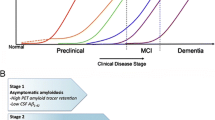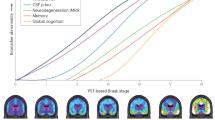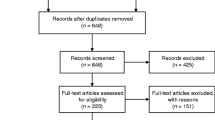Abstract
The use of biomarkers for diagnostics of Alzheimer’s disease (AD) has increased over the last years in specialized care and experimental settings. With the possibly upcoming availability of disease-modifying therapeutic agents, the diagnostics and treatment of patients with cognitive impairment will change. Biomarkers will be used as theranostic markers for case finding. The development and evaluation of biomarkers can be framed in a phase model from preclinical studies through trials in expert center settings to the evaluation of biomarkers in primary care, up to testing the efficacy and the impact of biomarkers on the healthcare system. Hippocampal volumetry is the most accepted and in-depth tested biomarker for AD diagnostics and prediction of the course. Therefore, hippocampus volumetry is used to illustrate the phase model of biomarker development and present the milestones already achieved and questions still to be resolved.
Zusammenfassung
Die Diagnostik der Alzheimer-Krankheit an spezialisierten Zentren hat sich bereits durch die vermehrte Nutzung von Biomarkern verändert. Eine eventuell in den nächsten Jahren bevorstehende Zulassung von krankheitsmodifizierenden Medikamenten zur Behandlung der Alzheimer Krankheit wird den Ablauf der Regeldiagnostik beeinflussen. Biomarker werden dann als wichtiges Theranostikum benötigt. Ein Phasenmodell beschreibt die Entwicklung und Erprobung von Biomarkern von der präklinischen Suche nach möglichen Zielmarkern über wissenschaftliche Untersuchungen in experimentellen Stichproben bis hin zur Erprobung der Effektivität eines Biomarkers in der Primärversorgung. Der bisher am umfangreichsten untersuchte Biomarker zur Diagnostik und Prädiktion des Verlaufs einer Alzheimer-Krankheit ist das Volumen des Hippokampus. Anhand der Hippokampusvolumetrie werden die bereits erreichten Meilensteine aufgezeigt und die noch offenen Fragen bei der Entwicklung von Biomarkern für die Alzheimer-Krankheit dargestellt.

Similar content being viewed by others
References
Albert MS, Dekosky ST, Dickson D et al (2011) The diagnosis of mild cognitive impairment due to Alzheimer’s disease: recommendations from the National Institute on Aging-Alzheimer’s Association workgroups on diagnostic guidelines for Alzheimer’s disease. Alzheimers Dement 7:270–279
Anonymous (2001) Biomarkers and surrogate endpoints: preferred definitions and conceptual framework. Clin Pharmacol Ther 69:89–95
Ball MJ (1977) Neuronal loss, neurofibrillary tangles and granulovacuolar degeneration in the hippocampus with ageing and dementia. A quantitative study. Acta Neuropathol 37:111–118
Biomarkers Definitions Working Group (2001) Biomarkers and surrogate endpoints: preferred definitions and conceptual framework. Clin Pharmacol Ther 69:89–95
Bobinski M, De Leon MJ, Wegiel J et al (2000) The histological validation of post mortem magnetic resonance imaging-determined hippocampal volume in Alzheimer’s disease. Neuroscience 95:721–725
Boccardi M, Ganzola R, Bocchetta M et al (2011) Survey of protocols for the manual segmentation of the hippocampus: preparatory steps towards a joint EADC-ADNI harmonized protocol. J Alzheimers Dis 26(Suppl 3):61–75
Braak H, Braak E (1991) Neuropathological stageing of Alzheimer-related changes. Acta Neuropathol 82:239–259
Brueggen K, Dyrba M, Barkhof F et al (2015) Basal forebrain and hippocampus as predictors of conversion to Alzheimer’s disease in patients with mild cognitive impairment – A multicenter DTI and volumetry study. J Alzheimers Dis 48:197–204
Clerx L, Van Rossum IA, Burns L et al (2013) Measurements of medial temporal lobe atrophy for prediction of Alzheimer’s disease in subjects with mild cognitive impairment. Neurobiol Aging 34:2003–2013
De Leon MJ, George AE, Stylopoulos LA et al (1989) Early marker for Alzheimer’s disease: the atrophic hippocampus. Lancet 2:672–673
De Leon MJ, Golomb J, George AE et al (1993) The radiologic prediction of Alzheimer disease: the atrophic hippocampal formation. AJNR Am J Neuroradiol 14:897–906
Frisoni GB, Jack CR Jr., Bocchetta M et al (2015) The EADC-ADNI Harmonized Protocol for manual hippocampal segmentation on magnetic resonance: evidence of validity. Alzheimers Dement 11:111–125
Galluzzi S, Geroldi C, Ghidoni R et al (2010) The new Alzheimer’s criteria in a naturalistic series of patients with mild cognitive impairment. J Neurol 257:2004–2014
Gosche KM, Mortimer JA, Smith CD et al (2002) Hippocampal volume as an index of Alzheimer neuropathology: findings from the Nun Study. Neurology 58:1476–1482
Hampel H, Prvulovic D, Teipel S et al (2011) The future of Alzheimer’s disease: the next 10 years. Prog Neurobiol 95:718–728
Jack CR Jr., Dickson DW, Parisi JE et al (2002) Antemortem MRI findings correlate with hippocampal neuropathology in typical aging and dementia. Neurology 58:750–757
Kesslak JP, Nalcioglu O, Cotman CW (1991) Quantification of magnetic resonance scans for hippocampal and parahippocampal atrophy in Alzheimer’s disease. Neurology 41:51–54
Mckhann GM, Knopman DS, Chertkow H et al (2011) The diagnosis of dementia due to Alzheimer’s disease: recommendations from the National Institute on Aging-Alzheimer’s Association workgroups on diagnostic guidelines for Alzheimer’s disease. Alzheimers Dement 7:263–269
Panza F, Seripa D, Solfrizzi V et al (2016) Emerging drugs to reduce abnormal beta-amyloid protein in Alzheimer’s disease patients. Expert Opin Emerg Drugs. doi:10.1080/14728214.2016.1241232
Pepe MS, Cai T, Longton G (2006) Combining predictors for classification using the area under the receiver operating characteristic curve. Biometrics 62:221–229
Pepe MS, Etzioni R, Feng Z et al (2001) Phases of biomarker development for early detection of cancer. J Natl Cancer Inst 93:1054–1061
Risacher SL, Saykin AJ, West JD et al (2009) Baseline MRI predictors of conversion from MCI to probable AD in the ADNI cohort. Curr Alzheimer Res 6:347–361
Schuff N, Woerner N, Boreta L et al (2009) MRI of hippocampal volume loss in early Alzheimer’s disease in relation to ApoE genotype and biomarkers. Brain 132:1067–1077
Teipel S, Drzezga A, Grothe MJ et al (2015) Multimodal imaging in Alzheimer’s disease: validity and usefulness for early detection. Lancet Neurol 14:1037–1053
Teipel SJ, Keller F, Thyrian JR et al (2017) Hippocampus and basal forebrain volumetry for dementia and mild cognitive impairment diagnosis: could it be useful in primary care? J Alzheimers Dis 55:1379–1394
Thyrian JR, Fiss T, Dreier A et al (2012) Life- and person-centred help in Mecklenburg-Western Pomerania, Germany (DelpHi): study protocol for a randomised controlled trial. Trials 13:56
Varon D, Barker W, Loewenstein D et al (2015) Visual rating and volumetric measurement of medial temporal atrophy in the Alzheimer’s Disease Neuroimaging Initiative (ADNI) cohort: baseline diagnosis and the prediction of MCI outcome. Int J Geriatr Psychiatry 30:192–200
Wolf D, Bocchetta M, Preboske GM et al (2017) Reference standard space hippocampus labels according to the EADC-ADNI harmonized protocol: Utility in automated volumetry. Alzheimers Dement. doi:10.1016/j.jalz.2017.01.009
Author information
Authors and Affiliations
Corresponding author
Ethics declarations
Conflict of interests
I. Kilimann, J.R. Thyrian, W. Hoffmann and S.J. Teipel declare that they have no competing interests.
This article does not contain any studies with human participants or animals performed by any of the authors.
The supplement containing this article is not sponsored by industry.
Rights and permissions
About this article
Cite this article
Kilimann, I., Thyrian, J.R., Hoffmann, W. et al. Translation of imaging biomarkers from clinical research to healthcare. Z Gerontol Geriat 50 (Suppl 2), 84–88 (2017). https://doi.org/10.1007/s00391-017-1225-3
Received:
Revised:
Accepted:
Published:
Issue Date:
DOI: https://doi.org/10.1007/s00391-017-1225-3




